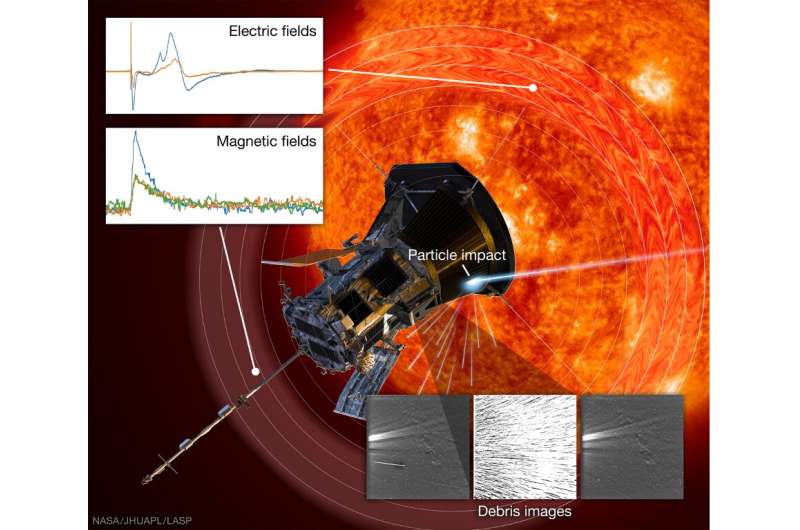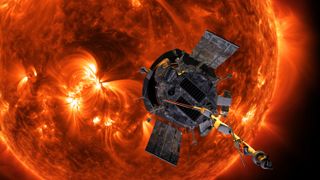Tiny grains, severe damage: Hypervelocity dust impacts on a spacecraft produce plasma explosions and debris clouds

The Parker Solar Probe spacecraft, NASA's newest and most ambitious effort to study the sun, has broken a lot of records: it has gotten closer to the sun than any other spacecraft to date, its instruments have operated at the hottest temperatures, and the probe is the fastest human-made object ever. But those records come at a cost: The spacecraft is moving so fast that running into even a tiny grain of dust can lead to serious damage.
New research by scientists at the Laboratory for Atmospheric and Space Physics (LASP) at the University of Colorado, Boulder and the Johns Hopkins University Applied Physics Laboratory (APL) examines collisions between the Parker Solar Probe spacecraft and dust. Led by David Malaspina, a researcher at LASP, and Assistant Professor in the Astrophysical and Planetary Sciences Department at the University of Colorado, the team drew on electromagnetic and optical observations from Parker Solar Probe to produce the most complete picture yet of how hypervelocity dust impacts may damage a spacecraft and disturb its operations.
Traversing near-sun space at up to 180 kilometers per second (about 400,000 miles per hour), Parker Solar Probe plows through the densest region of the zodiacal cloud. The zodiacal cloud is a thick, pancake-shaped dust cloud that extends throughout the solar system and is made up of tiny dust grains shed from asteroids and comets. As Parker Solar Probe barrels through this region, thousands of tiny (about 2 to 20 microns in diameter, or less than a quarter of the width of a human hair) dust grains strike the spacecraft at hypervelocity (faster than 6,700 miles per hour). Upon impact, the material that makes up the dust grains and the spacecraft surface is heated so much that it first vaporizes, then ionizes. Ionization is a process where atoms in the vaporized material are separated into their constituent ions and electrons, producing a state of matter called plasma. The rapid vaporization and ionization creates a plasma explosion lasting less than one thousandth of a second. The largest of these impacts also generate clouds of debris that slowly expand away from the spacecraft.
In the new study, Malaspina and colleagues used antennas and magnetic field sensors to measure disturbances to the electromagnetic environment around the spacecraft produced by dust impact plasma explosions (Figure 1). The findings could lead to new insights into space weather around the sun. For example, these measurements allowed the team to study how these plasma explosions interacted with the solar wind, or the stream of ions and electrons that the sun generates on a constant basis.
"With these measurements, we can watch the plasma created by these dust impacts be swept away by the flow of the solar wind." Malaspina said. He added that learning how this "pick up" process works on a small scale may help scientists better understand how larger plasma regions, such as those in the upper atmospheres of Venus and Mars, are swept away by the solar wind.
The findings also have major implications for the safety of Parker Solar Probe and spacecraft that will come after it.
The team observed how metallic flakes and paint chips knocked loose during collisions with dust drifted and tumbled near the spacecraft. Those pieces of debris created streaks in the images taken by navigational and scientific cameras on Parker Solar Probe.
"Many image streaks look radial, originating near the heat shield," said study co-author Kaushik Iyer of APL, referring to the large shield that protects Parker Solar Probe from the intense heat near the sun. The study also reports that some debris scattered sunlight into the Parker Solar Probe navigation cameras, temporarily preventing the spacecraft from determining how it was oriented in space. That can be a dangerous prospect for a spacecraft that relies on precise pointing of its heat shield to survive.
Parker Solar Probe was launched in 2018 and has completed nine full orbits of the sun. Before its prime mission ends in 2025, it will complete another 15 orbits.
As Parker Solar Probe continues its journey of exploration near the sun, it can now add one more record to its long list: most sand-blasted spacecraft.
The results of this study will be presented on November 11, 2021, at the 63rd Annual Meeting of the APS Division of Plasma Physics in Pittsburgh, PA.
Researchers get a look at the sun's dusty environment
More information: Abstract: TO06.00006. Rapid plasma bursts and lingering debris clouds driven by hypervelocity dust impacts on Park Solar Probe: and unintentional active experiment in the inner heliosphere
Provided by American Physical Society
Hypervelocity dust impacts cause plasma explosions on Parker Solar Probe
By Charles Q. Choi

The fastest spacecraft ever flown, NASA's Parker Solar Probe, regularly experiences high-speed collisions with dust particles that create explosions of plasma, a new study finds.
Launched in 2018, the Parker Solar Probe is NASA's latest and most ambitious effort to investigate the sun. To date, it has gotten closer to the sun than any other mission; its equipment has operated at the hottest temperatures of any spacecraft; and the probe is the fastest human-made object ever.
However, the extraordinary speed at which the Parker Solar Probe flies — about 447,000 mph (720,000 kph) during its closest approaches to the sun — means that running into even a tiny grain of dust can trigger explosions, which could make the probe the most sand-blasted spacecraft ever.

Measurements of electric fields, magnetic fields, and camera images reveal the plasma explosions and clouds of debris created when very high velocity dust impacts the Parker Solar Probe spacecraft. By watching the dispersal of these small plasma and debris clouds, scientists can learn about how larger clouds of dust and debris are blown away from stars.
"The Parker Solar Probe has been struck by dust tens of thousands of times," study lead author David Malaspina, a space plasma physicist at the University of Colorado, Boulder, told Space.com. "During its ninth orbit of the sun, of 24 total planned orbits, there were periods where the Parker Solar Probe was struck by a hypervelocity dust grain every 12 seconds on average."
To learn more about the kind of havoc these collisions might wreak, the researchers analyzed data gathered by the probe's antennas and magnetic field sensors. The result is the most complete picture yet of how hypervelocity dust impacts — ones that occur at more than 6,700 mph (10,780 km/h) — may damage a spacecraft and disturb its operations.
While flying near the sun, the Parker Solar Probe barrels through the densest region of the zodiacal cloud. This thick, pancake-shaped cluster of dust, which extends throughout the solar system, is made up of tiny dust grains from asteroids and comets.
As the spacecraft hurtles through this cloud, thousands of dust grains about 2 to 20 microns wide strike it at hypervelocity, generating explosions that last less than a thousandth of a second. In comparison, the average human hair is about 100 microns wide.
Upon impact, the dust grains and the impacted spacecraft surface get heated so much that they vaporize and then fragment into electrons and ions, forming plasma, the same state of matter that makes up stars and lightning.
"While most dust impacts cause only small effects, a few are very high energy, creating the debris and dense plasma clouds that we focused on in this research," Malaspina said. "We identified about 250 of these very high-energy impacts during the first eight orbits of Parker Solar Probe around the sun."
The largest of these collisions also generate clouds of debris that slowly expand away from the probe.
"Dust impact plasma clouds have been observed on spacecraft since the 1980s, when Voyager passed through the ring plane of Saturn, but no impact plasma cloud observed prior to this has been dense enough to cause such clearly measurable effects," Malaspina said.
As much as dust is pummeling the Parker Space Probe, it remains operational, Malaspina noted. "Most of the dust grains that strike the spacecraft are very small," Malaspina noted. "While this very efficiently sandblasts the spacecraft surface, the risk of encountering a dust grain large enough to cause a catastrophic failure remains low."
This new data can help scientists tinker with spacecraft designs to better protect them from hypervelocity impacts, as well as the resulting plasma and debris, Malaspina said.
For example, researchers may want "to carefully consider the fragmentation properties of exterior materials under hypervelocity impacts," he explained. "This is particularly true for missions where uninterrupted star camera navigation is important, or where electromagnetic attraction of spacecraft debris to spacecraft surfaces may be a concern."
This research is also helping scientists map the structure and density of the interplanetary dust cloud near the sun, "which has never been done with direct spacecraft measurements," Malaspina said. "This can inform updated models of this environment and drive more accurate predictions of dust impact danger on any future missions."
In addition, these findings could lead to new insights into space weather around the sun. For example, the measurements allowed the team to study how these plasma explosions interacted with the solar wind, the stream of particles flowing from the sun. This information, in turn, can shed light on how larger amounts of plasma, such as those found in the upper atmospheres of Venus and Mars, are swept away by the solar wind, Malaspina said.
The scientists will detail their findings Nov. 11 at the annual meeting of the American Physical Society's division of plasma physics in Pittsburgh. They have also submitted their work to the Astrophysical Journal.
—NASA sun spacecraft whizzes through 9th solar flyby
—Parker Solar Probe: Mission to touch the sun
—Space weather: Sunspots, solar flares & coronal mass ejections


No comments:
Post a Comment